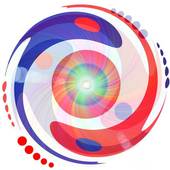Chakras








We are all made out of energy and the chakras are our centers of energy.
Quantum Physics is showing us that everything is made from the same energy. The energy vibrates in different wavelengths to give us all the things we see and experience in our universe.
We, too, are made from this energy and have 'energy bodies' in addition to our physical bodies. Within our energy bodies are the seven chakras or energy centers that regulate certain of our physical organs and areas of our lives.
There are major and minor chakras and the word "chakra" means "wheel of light".
The chakras represent areas of energy concentration - each chakra's energy spins around a central point, like a wheel spinning around an axle.
The seven major chakras are arranged vertically from the base of the spine to the top of the head and each chakra is associated with a physical part of your body like the organs, nerves, and glands and they are connected to one of the 5 elements of the earth.
Chakras do not
guide energy flow from one place to another in the body relatively
the same as meridian (pathway of energy) do, but are centers of
energy in themselves. They are similar to centers of force,
located within our etheric body, through which we receive, transmit
and process life energies.
Every part of your
body vibrates with a different frequency of energy.
-The chakras act like a series of valves in a system connecting a water tap to a garden hose. If this tap is turned on the water (energy) should flow smoothly through the system –but if there is a kink on the hose (analogous to a blockage of energy), or equally if any of the valves are too open or too closed, this will affect the proper functioning of the whole coordination. – Liz Simpson
Each seven chakras are recognized as a focal point of life force energy in relation to the physical, emotional, mental and spiritual energies, and radiate a specific color, sound, and spiritual qualities which are associated with corresponding psychological, physical, and emotional states necessary for the development of the whole person.
The chakras are the network through which the body, mind, spirit interact as one holistic system; they receive, transmit and process life force energy.
They govern the subtle,
psychosomatic aspects of our inner life -
They are each
associated with particular functions within the body and with
specific life issues which we handle both inside ourselves and in
our interactions with the world. Through external situations and
internal habits, a chakra can become either deficient or excessive,
and imbalanced.
In addition our chakra become dysfunctional, not only through being too open but also by vibrating, or spinning sluggishly because of some emotionally based blockage usually rooted in childhood.
If you have health problems or difficulties in your life, the source is often negative energy that has been lodged in your energy fields as the result of some past trauma or exposure to negativity from your environment.
The lower chakras focus on details such as our home, family, and emotions, while the upper chakras focus on the spiritual aspect of our lives.
By maintaining an open and smooth flowing channel of energy through our chakras, we can free ourselves of the mental or emotional traumas that anticipate the onset of physical dis-ease.
The main purpose in working with and understanding the chakras is to create integration and wholeness within ourselves - in this way we group the various aspects of our consciousness, from the physical to the spiritual, into a harmonious relationship.
All of these chakras affect one another and work together as one.
If we take the time and direct our attention and energy to any area of our body we will bring energy to that part of the body.
Yoga postures will help us to get these energy centers in balance so they can release their qualities to re-establish our inner balance and restoring our health, and form.
It is important to note that each yoga posture affects the meridians and their corresponding chakras as well.
1st Chakra:
The 1st chakra, muladhara (mula means root and dhara means base) is located above the anus, near the perineum or cervix. This chakra helps you to be grounded and centered. It gives vitality to the physical body and to the Life-force, and is associated with survival instincts; the concerns associated with this chakra involve food, clothing, and shelter - practical things.
The emotion associated with this chakra is fear; the less we are
connected to the
earth, the more fear we have. The healthy sides of this chakra
demonstrate stability, safety and belongingness; this chakra help
you focus on the body as health, diet, fitness and work. You enjoy
taking care of your home.
It is said that within this chakra lie a dormant energy to be awaken. This energy is called Shakti the feminine source energy. This potent energy need to be released through all the chakras to transform the body and mind into more refined levels of consciousness.
Adrenal glands are associated with the 1st chakra, and it is also related to the kidney, urinary bladder, and small intestine meridians.
The sound associated to this chakra is LAM and the element for this chakra is earth; this chakra grounds us to the earth.
If the 1st chakra is congested, we may have a tendency towards hoarding things, being materialistic. And if it is blocked we can feel insecure or fearful, disassociated from our bodies and others; feeling of not being worthy to be here on earth.
To get the energy moving, let go of things, give them away, and release them. This pertains to mental and emotional things as well as material things. Holding on to things keeps the energy from flowing freely.
In yoga, standing poses balance and strengthen the 1st chakra, which helps the body become more grounded.
The color for this chakra is red and it is associated with the sense of smell.
Yoga Poses to activate this Chakra are:
Squat - Standing poses (warriors, eagle, tree pose) - Staff pose with Mula bandha - seated boat- spinal roll- Bridge/wheel- Half and full wind relieving -child poses.
Affirmation:
“I have the right to be"
“May I be able to nourish and nurture myself, be grounded, stable, and feel connected to the oneness of life/universe”
2nd
chakra
The 2nd chakra Svadhisthana which means “one’s own place” and is located in the lower abdomen, between the navel and the pelvis.
The 2nd chakra is associated with our sexuality and all the issues that surround it. It does also govern emotional and sensual aspects of our lives. It is closely related to the hips, kidney and to the organs of reproduction. It sound is VAM.
The emotion associated with the 2nd chakra is passion. If you grew up in an environment where emotions were repressed or denied, this chakra may be deficient. Some signs of deficiency are fear of pleasure, being out of touch with one's feelings and resistance to change.
When this chakra is excessively open, it may manifest as overly emotional behavior, sexual addiction or poor boundaries – we may be overly influenced by other people’s emotion, ruled by emotions rather than allowing them to flow through.
The element of Svadhisthana is water, thus the association with the liquids of the body. Water flows, moves and changes. A balanced 2nd chakra is about embracing movement and change in our lives.
Here we learn how to move our body physically, helping our muscles to relax, and move chronically blocked energy needed to generate energy needed for the next chakra.
The second chakra will explore our polarities - our light side and our shadow, our strength and our vulnerability, our feminine and masculine side - willing to embrace both sides to achieve balance and go on.
So we have moved from the grounded stability of the first chakra, rooted at the base to a place of more movement and fluidity, bringing up buried emotions - blocked emotions represses movement and restrict the flow of energy through the body as a whole.
While the first chakra is about our need to be secure, the second chakra begins to include our need to explore and be with others.
The color for the 2nd chakra is orange, and it is associated to the sense of taste
Yoga Poses to activate the 2nd chakra are:
Dancing- Lying butterfly- Pelvic rock- Leg Lifts- cat pose- Frog pose- triangle pose- warrior2- pigeon pose- supine twist pose from one side to the other-
Affirmation:
“I have the right to feel”
“May I be at home and at ease in my body, and find balance in my relationships between myself and others.”
3rd chakra
The 3rd chakra "Manipura" means "lustrous gem." It is located in the area of the solar plexus, and digestive system, and is associated with power, self-esteem and vitality. It is the seat of the intellect, and of the ego. It is about our personal power and will.
Our two first chakras with the element earth and water are subject to gravity with downward flow, now we move to fire in this third chakra which sends his heat upward necessary for transformation. Physiologically this refers to metabolism, which changes food and water into energy and heat. Psychologically, this relates to our expression of personal power and will.
When the 3rd chakra is excessive, anger, hatred, too much attention to power, status and recognition can be present. People with excessive Manipura chakra often can show aggressive attitude; those will crave substances that sedates as alcohol, tranquilizers because they soothe the hyperactive nervous system and bring a feeling of ease.
When it is deficient, one can have digestive problems, eating disorders, low self-esteem and a feeling of powerlessness; those will be drawn to addictive substances that give illusion of energy as sugar, coffee, cigarette, cocaine.
Blockage in this chakra may show up as a self-sacrificing behavior that is motivated by shame because not living the true self desires and having a sense of worthlessness - this is somebody that does not have enough self-esteem to pursue her own journey.
Bringing consciousness to our roots, our past, and working through our feelings are the methods of recovering from that shame and restoring a healthy third chakra – as a weaver of matter and consciousness for inner power.
When the third chakra is balanced it manifests feelings of self –confidence and self-esteem embodying a feeling of ease and warmth. It manifests a power coming from within, and is either oppressive or submissive.
After exploring the polarities in the second chakra, we now combine them to give power to the third chakra toward a manifest goal.
The color for the 3rd chakra is yellow and its sound is RAM..
Yoga Poses to activate the 3rd Chakra are:
Woodchopper- Sun salutation- Warrior III as the plane- Bow- boat- reversed plank and spinal twists. Passive backbends will be good for calming an excessive 3rd chakra.
Affirmation:
“I have the right to act, the right to follow my path” -
“May I be able
to honor myself, be who I
am in the world, and express that power without
fear.”
4th chakra
The 4th chakra Anahata means "unstruck" or “unhurt”. This seems to imply for me that deep beneath our brokenness and pain, it is our nature to love, to be gentle, and compassionate. When all thoughts drop away or are ignored, love is our natural state.
This love exists within the individual as an expansive state of the spirit, the interconnectedness and response of life. The only thing that ever interferes with love is a thought, usually a judgment or a fear.
The 4th chakra is located in our heart center and thus is also known as the heart chakra.
Heart chakra is a point of balance as it is the ceiling of the lower world and the root of the upper world; it is the integrator between the world of the spirit and matter.
It governs our love and the primary color for the 4th chakra is green and the secondary color is pink. The parts of the body associated with it are thymus, heart, lungs, chest, arms, and breasts and its element is air. Pranayama practice helps to balance this chakra; when we work with the air as we interact with it through the breath, we have access to the physical and spiritual aspects of the heart chakra. Its sound is YAM.
The emotion of the heart chakra is compassion and joy; Anahata feels the suffering of others.
The principle of equilibrium governs the heart chakra. When we truly enter into balance with ourselves, our relationships, and our environment, we enter a deep sense of serenity and peace.
“One of the task of the heart chakra is to move into a state of balance with all around us, letting our heart beat in unison with the heartbeat of the web of life, through which we are intricately connected” – Anodea Judith.
When the 4th chakra is deficient, you may experience feelings of shyness and loneliness, depressive, lack of empathy and an inability to forgive. Physical conditions can include shallow breathing, asthma, and some lung diseases.
When the 4th chakra is excessive one may experience co-dependency, possessiveness, tendency to give everything away, and to be so focused on others that one ignores the core identity. Again our choice is healthy balance.
When the heart chakra closed down the very core of the chakra system is distraught and it is difficult for the energy to pass between upper and lower body. This could be the result of abandonment, neglect, emotional abuse or shame.
The task of this chakra is to move into a state of balance with all around us.
In yoga, poses that stimulate the 4th chakra are backward bends (anything that opens the chest). A powerful way to energize this chakra is to love ourselves and others.
Yoga poses that are good for the 5th chakra are:
Cow face (using a belt to open the chest)- Camel - Lotus- Standing backbend-standing yoga mudra- balancing half moon- Cobra - Breathing!
Affirmation:
“I have the right to love and to be loved.”
“May I be free to feel my true feelings, desires and passions, and be at home in my heart.”
5th chakra
The 5th chakra “Vishuddha" means "purity." This is the first of the chakras that focuses primarily on the spiritual plane.
As we leave the balance point of chakra four, we use our will to push our breath upwards, into our throat chakra, where we turn it into sound, communicating our truth.
The 5th chakra is located in the throat and governs higher communication, speaking, hearing and listening. It helps us to understand our inner truth and convey it with our voice to the outside world. Its sound is HAM.
Chanting, singing, speaking, reading aloud are all good for the 5th chakra; the vibrations of all these things affect the body down to the cellular level.
The element for the 5th chakra is space. It is connected to the cosmos. It is associated with the thyroid, parathyroid, jaw, neck, mouth, throat, tongue, and larynx.
When this chakra is open, we can find our own voice, we feel able to speak our truth. And when it is blocked we may be able to talk about what is not important for us but unable to speak about what is really true to us. And excessive speech functions as a defense.
Deficient energy in the 5th chakra can cause neck and shoulder problems, jaw disorders, throat problems, an under active thyroid and a fear of speaking.
On the other hand, excessive energy in the 5th chakra can cause hearing problems, inability to listen, excessive talking and an overactive thyroid.
The color for the 5th chakra is blue, as the color of the sky.
Yoga poses that are good for the 5th chakra are:
Neck and shoulder rolls and stretches, rabbit pose, shoulder stand, plow pose, fish pose.
Affirmation:
“May I be able to express my feelings with ease, and be balanced between heart and mind.”
“What I have to say is worthy of being listened to.”
6th chakra
The 6th chakra “Ajna” means "to perceive or to know”
The 6th chakra is located between, and just above the eyebrows. It is often referred to as the "third eye." This chakra deals with visualization, intuition, imagination and telepathy.
- Every day we talk about “hunches” when we know things we cannot rationalize.
At chakra five we experienced the wavelike emission of sound and its ability to carry information through vocal ability as word, song. Now at chakra six we experience the perception of wavelike phenomenon of a higher octave – that of light and its ability to bring information in the form of colors and images.
Pituitary gland, eyes, head and lower brain are associated with the 6th chakra, and its color is indigo/purple, both spiritual colors. Its sound is OM.
Ajna is about seeing; that chakra receives stores, creates and projects visually encoded information.
When this chakra is dominant, one may have clairvoyant abilities...being able to see things that others can't.
When the energy in the 6th chakra is excessive, it can cause headaches, hallucinations, nightmares and difficulty in concentrating. But when the energy is deficient, there may be eye problems, poor memory, and inability to visualize.
Yoga poses for the 6th chakra are:
Eyes exercises
Supported forward bends
Supported back bends
Restoratives poses with positive visualizations and meditation will strengthen this chakra.
Affirmation:
“I trust my inner self to guide and protect me”
“I choose to accept myself and others exactly as we are”
7th chakra
The 7th chakra is "Sahasrara" which means "thousand fold” and symbolizes our infinite nature connecting us with the Divine. It is located at the crown of the head and serves as the crown of the entire chakra system, symbolizing the highest state of enlightenment.
In art, Christ is depicted with a halo around his head; this could represent the awakened spirituality of the 7th chakra.
This chakra relates
to thought, consciousness, information and intelligence. This
chakra is concerned with the way we think, our belief systems and
our connection to a higher power.
The crown chakra
relates to the process of knowing - to the ever growing matrix of
understanding.
Our task here is to examine our thoughts, our belief, and our process of receiving, analyzing and storing information.
Pineal glands, upper brain part of body are associated with the 7th chakra. Its sound is NNG.
The 7th chakra is sometimes associated with the color violet, but it is usually referred to as the color white, a combination of all colors - this is in line with the chakra also being a culmination of all the other chakras.
An excessive 7 chakra is demonstrated by people always in their head who seem to know it all, who insist on being right or who attempts to dominate others. The fact they overcompensating in the 7 chakra is often to balance deficiencies in the lower chakras.
Deficient energy manifests as people having trouble thinking for themselves, and rely on others to guide them.
“To work on the crown chakra is to examine and expand our consciousness. We do this by expanding our information bank, by reaching out, by learning and study. We do it by examining our belief systems, our internal programming, and working the “bugs” out of our operating system “ – Anodea Judith
Just as the first
chakra forms our roots in the material world, the seventh chakra is
our connection to the spiritual world, the expansion of
consciousness.
Allowing the other
chakras to flow freely will balance that chakra.
Meditation is the best yogic practice for the 7th chakra. Meditation clears and quiets the mind, in preparation for experiencing the Divine.
Yoga practice as meditation and Yoga nidra (guided relaxation).
Affirmation:
“I am starting to accept myself as I am, with love and gratitude.”
“I choose to live my life from a place of love and contentment.”
"The body is your temple. Keep it pure and clean for the soul to reside in” _ BKS Iyengar




